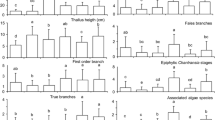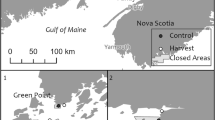Abstract
Vertebrata lanosa is a small red epiphytic alga growing almost exclusively on Ascophyllum nodosum. It has recently gained attention as a food alga in the North Atlantic. We examined distribution of V. lanosa in relation to environmental factors, by measuring cover of A. nodosum and V. lanosa in sample quadrats at 27 stations in an area in southwestern Norway. The probability of finding high cover (hotspots) of V. lanosa (defined as scores of V. lanosa belonging to the upper 25 % of data) was analysed in relation to height above Chart Datum, wave exposure, cardinal direction, inclination and substratum type. The relationship between amount (cover or volume) of the host alga (A. nodosum) and cover of V. lanosa was also examined. A significant and positive relationship between high cover of V. lanosa and increasing wave exposure was found, which may be attributed to the fact that wave action can cause scrapes and wounds on A. nodosum branches, where spores of V. lanosa have higher chances of successful settlement and survival. The results also showed a significant negative impact of high cover or large volume of A. nodosum on V. lanosa. Finally, the probability of finding high cover of V. lanosa was highest in the middle part of the Ascophyllum zone. The results suggest that the epiphyte and its main host do not have completely overlapping habitat requirements, and that sheltered areas with high biomass of A. nodosum are likely to contain relatively little V. lanosa for harvesting.







Similar content being viewed by others
References
Åberg P (1992) Size-based demography of the seaweed Ascophyllum nodosum in stochastic environments. Ecology 73:1488–1501
Armitage CS, Sjøtun K, Jensen KH (2014) Correlative evidence for competition between Fucus serratus and the introduced chlorophyte Codium fragile subsp. fragile on the southwest coast of Norway. Bot Mar 57:85–97
Baardseth E (1970a) Synopsis of biological data on knobbed wrack Ascophyllum nodosum (Linnaeus) Le Jolis. FAO Fisheries Synopsis No. 38 Rev. 1. Food and Agriculture Organization of the United Nations, Rome
Baardseth E (1970b) A quadrat-scanning, two-stage sampling method of estimating seaweed quantities. Norwegian Institute of Seaweed Research. Report no. Trondheim. Norway. 33:1–40
Bates D, Mächler M, Bolker B, Walker S (2015) Fitting linear mixed-effects models using lme4. J Stat Software 67
Bjordal MV (2018) Field studies on the abundance, growth and biofouling of the harvestable red alga Vertebrata lanosa (Linnaeus) T.A.Christensen. Thesis, Master of Science in Marine Biology, Department of Biological Sciences, University of Bergen
Burrows MT, Harvey R, Robb L (2008) Wave exposure indices from digital coastlines and the prediction of rocky shore community structure. Mar Ecol Prog Ser 353:1–12
Buschmann AH, Camus C, Infante J, Neori A, Israel Á, Hernández-González MC, Pereda SV, Gomez-Pinchetti JL, Golberg A, Tadmor-Shalev N, Critchley AT (2017) Seaweed production: overview of the global state of exploitation, farming and emerging research activity. Eur J Phycol 52:391–406
Chapman AL, Sévant P, Larssen WE (2015) Food or fad? Challenges and opportunities for including seaweeds in a Nordic diet. Bot Mar 58:423–433
Fralick RA, Mathieson AC (1975) Physiological ecology of four Polysiphonia species (Rhodophyta, Ceramiales). Mar Biol 29:29–36
Gabary DJ, Lining T, Burke J (1991) The Ascophyllum, Polysiphonia, Mycosphaerella symbiosis. II. Aspects of the ecology and symbiosis of Polysiphonia in Nova Scotia. Bot Mar 34:391–401
Garbary DJ, Deckert RJ (2004) Three part harmony - Ascophyllum and its symbionts. In: Seckbach J (ed) Symbiosis: Mechanisms and Model Systems. Kluwer, Dordrecht, pp 309–321
Garbary DJ, Deckert RJ, Hubbard CB (2005) Ascophyllum and its symbionts. VII. Three way interactions among Ascophyllum nodosum (Phaeophyceae), Mycophycias ascophylli (Ascomycetes) and Vertebrata lanosa (Rhodophyta). Algae 20:353–361
Garbary DJ, Miller AG, Scrosati RA (2014) Ascophyllum nodosum and its symbionts: XI. The epiphyte Vertebrata lanosa performs better photosynthetically when attached to Ascophyllum than when alone. Algae 29:321–331
Halat L, Galway ME, Gitto S, Garbary DJ (2015) Epidermal shedding in Ascophyllum nodosum (Phaeophyceae): seasonality, productivity and relationship to harvesting. Phycologia 54:599–608
Jorde I (1966) Algal associations of a coastal area south of Bergen, Norway. Sarsia 23:1–52
Levin PS, Mathieson AC (1991) Variation in a host epiphyte relationship along a wave exposure gradient. Mar Ecol Prog Ser 77:271–278
Longtin CM, Scrosati RA (2009) Role of surface wounds and brown algal epiphytes in the colonization of Ascophyllum nodosum (Phaeophyceae) fronds by Vertebrata lanosa (Rhodophyta). J Phycol 45:535–539
Longtin CM, Scrosati RA, Whalen GB, Garbary DJ (2009) Distribution of algal epiphytes across environmental gradients at different scales: intertidal elevation, host canopies, and host fronds. J Phycol 45:820–827
Maggs CA, Hommersand MH (1993) Seaweeds of the British Isles Volume 1 Rhodophyta Part 3A Ceramiales. British Phycological Society, The Natural History Museum, London
Meese RJ, Tomich PA (1992) Dots on the rocks: a comparison of percent cover estimation methods. J Exp Mar Biol Ecol 165:59–73
Pavia H, Toth GB (2000) Inducible chemical resistance to herbivory in the brown seaweed Ascophyllum nodosum. Ecology 81:3212–3225
Pearson GA, Evans LV (1990) Settlement and survival of Polysiphonia lanosa (Ceramiales) spores on Ascophyllum nodosum and Fucus vesiculosus (Fucales). J Phycol 26:597–603
Pedersen PM (2011) Grønlands havalger. Forlaget Epsilon.dk, Denmark
R Core Team (2019) R: a language and environment for statistical computing. R Foundation for Statistical Computing, Vienna http://www.R-project.org/. Accessed 10 Jan 2019
Reed RH (1983) The osmotic responses of Polysiphonia lanosa (L.) Tandy from marine and estuarine sites: Evidence for incomplete recovery of turgor. J Exp Mar Biol Ecol 68:169–193
Reed RH (1984) The effects of extreme hyposaline stress upon Polysiphonia lanosa (L.) Tandy from marine and estuarine sites. J Exp Mar Biol Ecol 76:131–144
Rees TK (1931) Preliminary observations on the Phaeophyceae of Lough Hyne (Ine). J Ecol 19:439–448
Rueness J (1977) Norsk algeflora. Universitetsforlaget, Oslo
Salvanes AGV, Glenner H, Askness DL, Asplin L et al (2018) Sampling gears and equipment. In: Salvanes AGV, Devine J, Jensen KH, Hestetun JT, Sjøtun K, Glenner H (eds) Marine Ecological Field Methods. Wiley Blackwell, Hoboken, pp 75–120
Scrosati RA, Longtin CM (2010) Research note: field evaluation of epiphyte recruitment (Vertebrata lanosa, Rhodophyta) in different microsite types on host fronds (Ascophyllum nodosum, Phaeophyceae). Phycol Res 58:138–142
Se havnivå Kartverket (2018) Se havnivå. https://kartverket.no/en/sehavniva/. Accessed 20 Mar 2018
Viestad A (2016) Norges ukjente delikatesser: Tang som smaker trøfler, og gress med kanel- og vaniljesmak. Dagbladet. https://www.dagbladet.no/mat/norges-ukjente-delikatesser%2D%2Dtang-som-smaker-trofler-og-gress-med-kanel%2D%2Dog-vaniljesmak/60344771. Accessed 20 Mar 2019 (in Norwegian)
Acknowledgements
The study was part of MVB’s Master work at the University of Bergen. We would like to thank Tomas Sørlie, Jon Åsmund Bjordal, Aud Vold and Bård Hugnes Bjordal for help with field work, and Caroline S. Armitage for the comments to the manuscript and help with language editing.
Author information
Authors and Affiliations
Corresponding author
Additional information
Publisher’s note
Springer Nature remains neutral with regard to jurisdictional claims in published maps and institutional affiliations.
Rights and permissions
About this article
Cite this article
Bjordal, M.V., Jensen, K.H. & Sjøtun, K. A field study of the edible red alga Vertebrata lanosa (Rhodophyta). J Appl Phycol 32, 671–681 (2020). https://doi.org/10.1007/s10811-019-01934-2
Received:
Revised:
Accepted:
Published:
Issue Date:
DOI: https://doi.org/10.1007/s10811-019-01934-2




